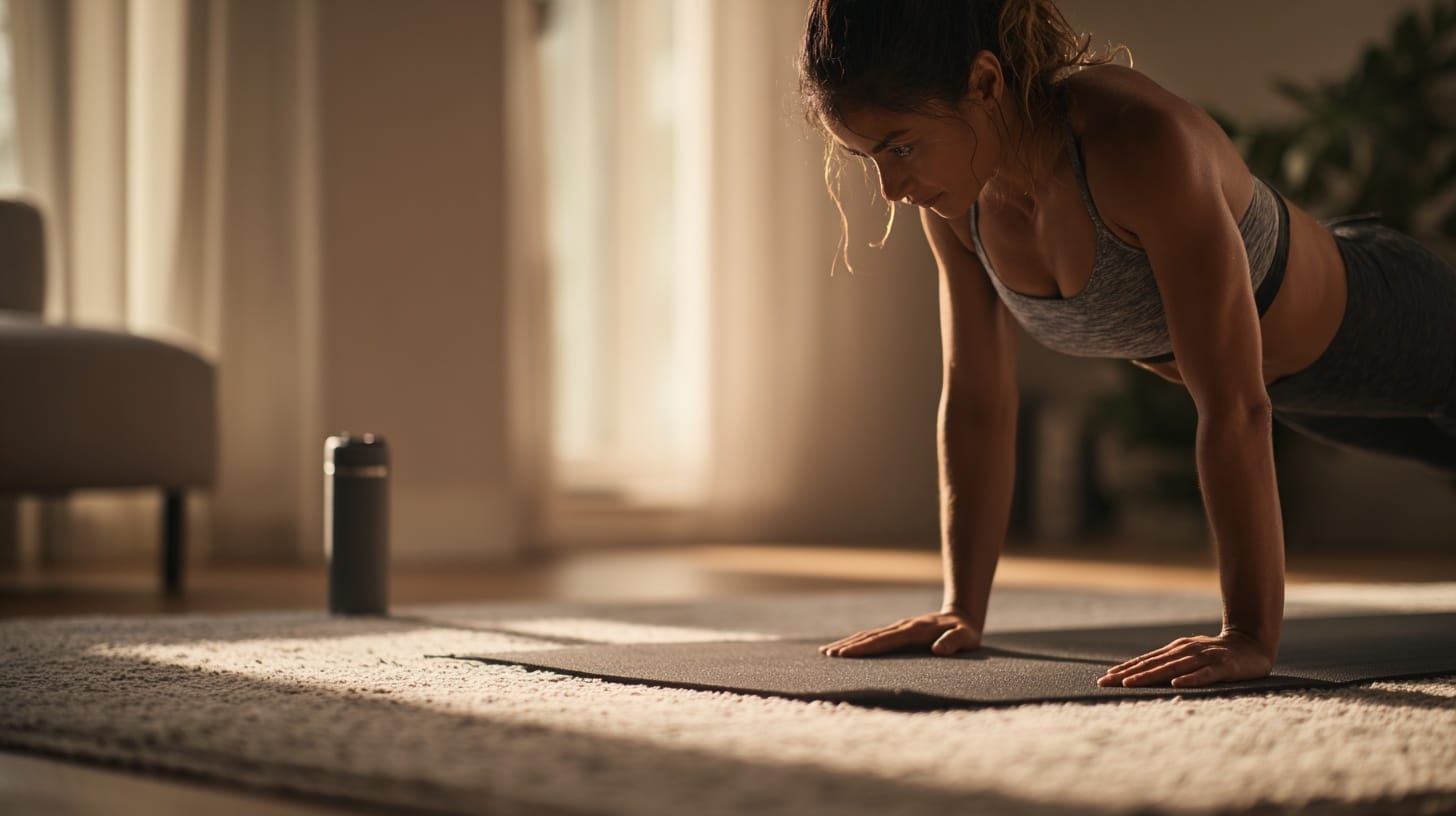I get it, life gets busy, and exercise often feels like the first thing to drop. The good news is you don’t need a gym, fancy equipment, or hours of free time to stay active.
Just a few minutes a day can boost your strength, improve your mood, and give you lasting energy. In this blog, I’ll walk you through 7 exercises to do every day that actually fit into real life.
You’ll see seven bodyweight moves, quick routines you can choose by time, tips for different ages, and even ways to track progress.
By the end, you’ll have an easy plan that helps you move daily, stay consistent, and feel healthier without overcomplicating it.
Why You Should Exercise Daily?
Moving your body each day helps more than just your muscles. It keeps your heart strong and your mind sharp. Regular exercise helps build strength, improve balance, and maintain flexibility as you age.
It also boosts your energy and can lift your mood. If you’re trying to manage your weight, daily movement makes a big difference. Over time, it also helps with posture, bone strength, and joint support.
Even a short routine can add up to big health benefits when done consistently. Just start small and stick with it.
Simple Yet Effective Exercises to Do Every Day
These moves need no equipment, work for all fitness levels, and cover strength, balance, and core stability in just minutes. Here are seven exercises you can practice daily to support overall fitness and well-being:
1. Squats
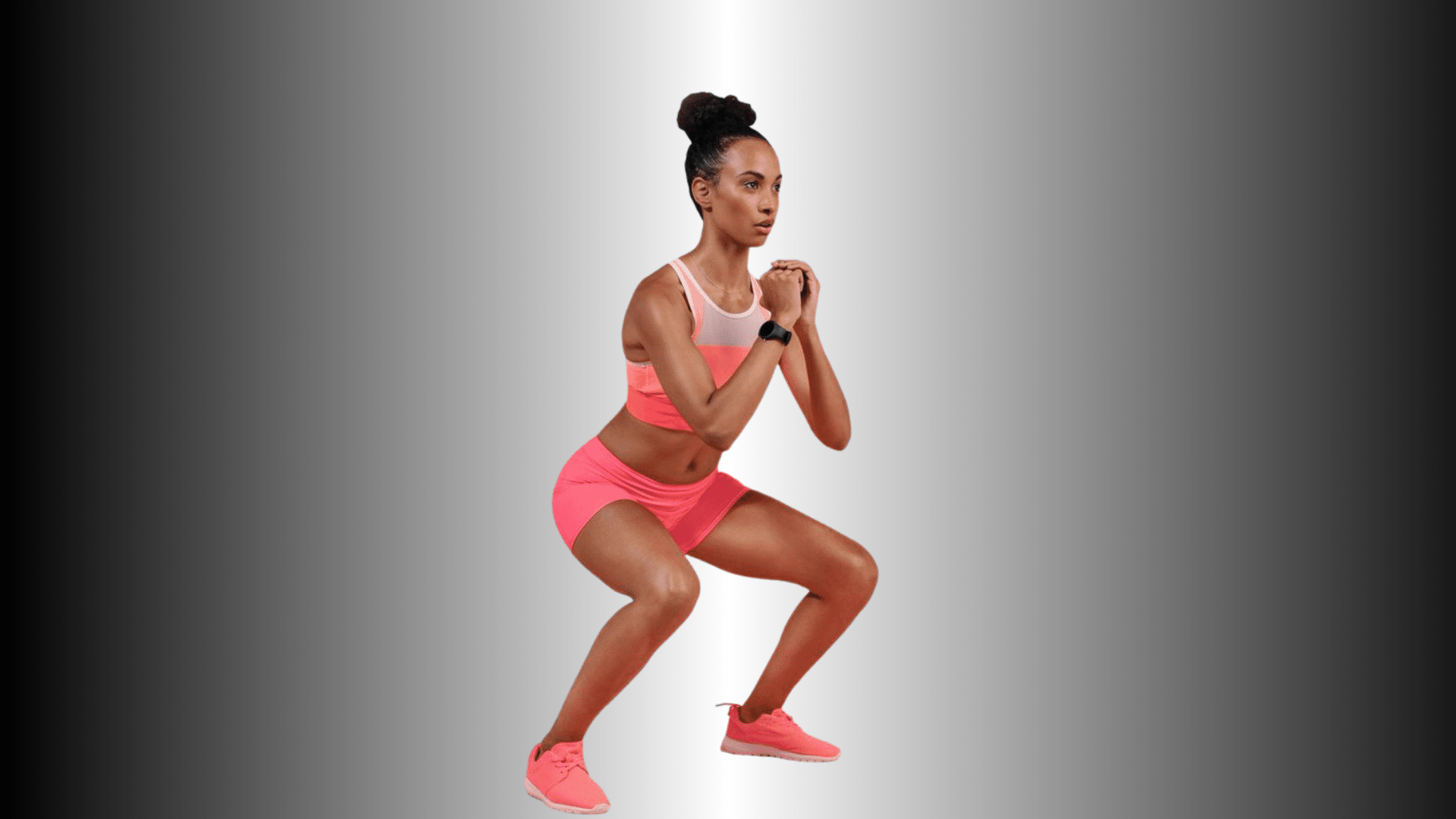
Risk Tags: knees, hips, lower back
Screen (Readiness Test): Stand facing a chair, feet shoulder-width apart. Sit down and stand up five times without using your hands. Keep heels down and knees tracking over toes. If knees cave in or heels lift, lower the depth or practice chair taps first.
Step-by-Step Instructions
- Stand tall, feet shoulder-width apart, toes slightly out.
- Brace your core. Lift your chest.
- Push your hips back like you’re sitting.
- Bend knees. Keep them in line with the toes.
- Go as low as you can with control.
- Press through heels to stand.
- Inhale on the way down, exhale as you rise.
Common Mistakes
- Knees are collapsing inward instead of tracking over toes.
- Heels lifting off the floor during the squat.
- Lower back rounding from leaning forward too far.
- Dropping quickly without control.
- Chest dropping forward instead of staying tall.
- Holding your breath instead of breathing steadily.
- Squatting deeper than you can maintain good form.
2. Push-Ups
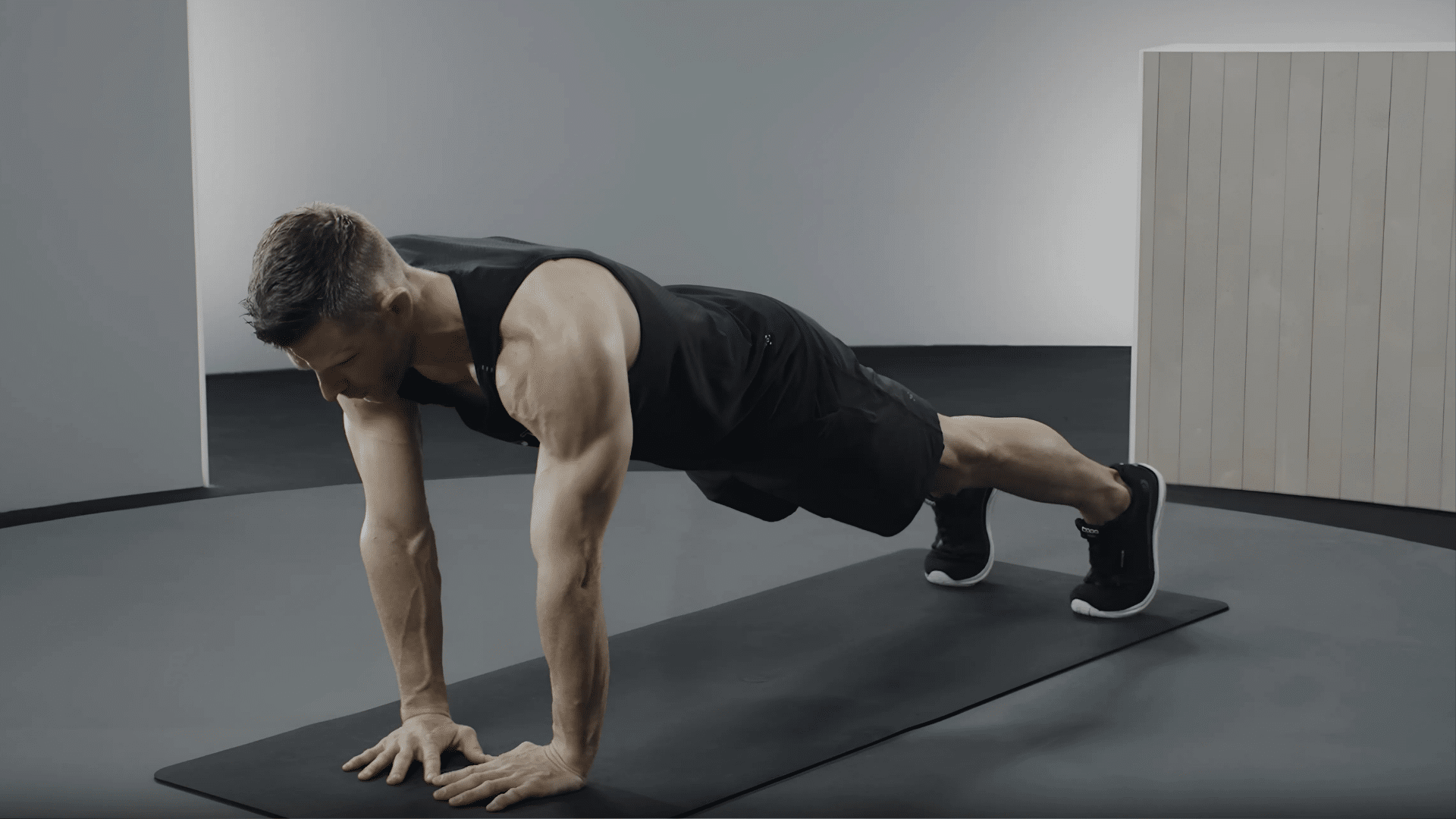
Risk Tags: wrists, shoulders, lower back
Screen (Readiness Test): Stand facing a wall, arms straight, hands on the wall at shoulder height. Lower your chest to the wall and push back for 10 smooth reps. Keep a straight line from head to heels. If hips sag or head drops, start with wall or incline push-ups.
Step-by-Step Instructions
- Place hands under shoulders. Step back.
- Form a straight line head to heels.
- Brace core. Squeeze glutes.
- Bend elbows to lower chest with control.
- Keep elbows about 45° from your sides.
- Press the floor away to return.
- Inhale down, exhale up.
Common Mistakes
- Letting hips sag or pike up instead of staying in a straight line.
- Elbows flaring straight out to the sides.
- Hands set too far forward or too close together.
- Neck dropping or craning upward.
- Failing to brace the core before lowering.
- Rushing through reps without control.
- Holding your breath instead of breathing rhythmically.
3. Lunges
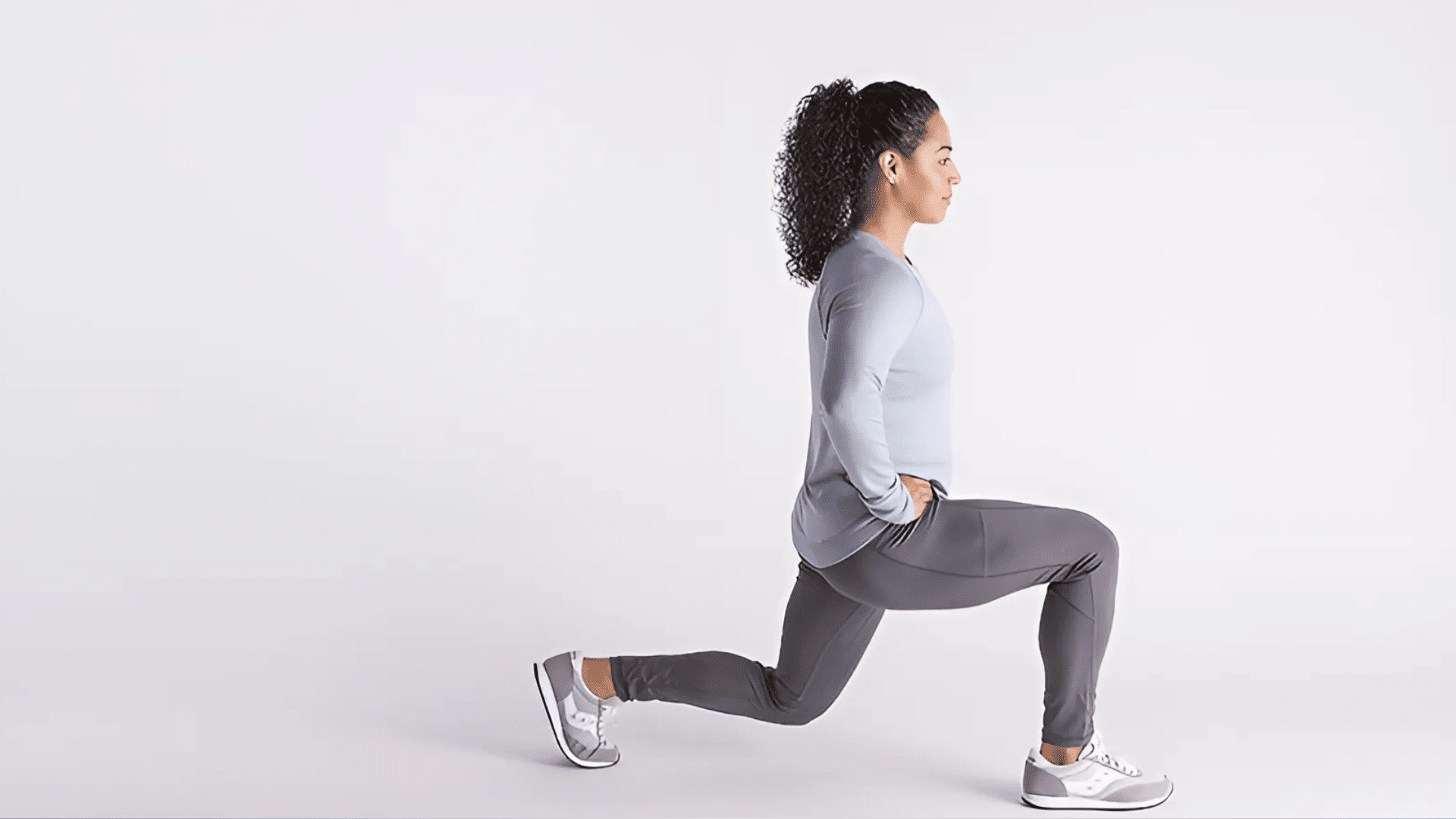
Risk Tags: knees, balance, ankles
Screen (Readiness Test): Stand near a wall. Step forward into a small lunge and lightly tap the wall for balance. Front knee stays behind toes. If you wobble or the knee shoots forward, shorten the step and practice supported lunges.
Step-by-Step Instructions
- Stand tall, feet hip-width.
- Step one foot forward.
- Lower until both knees bend comfortably.
- Front knee tracks over mid-foot.
- Keep your chest up, shoulders relaxed.
- Push through the front heel to stand.
- Switch sides each rep.
Common Mistakes
- Front knee traveling past toes.
- Knee collapsing inward during the lunge.
- Short stride causing cramped form.
- Leaning forward at the waist instead of staying tall.
- Back heel twisting inward.
- Moving too fast to stay balanced.
- Breath is becoming shallow or held.
4. Glute Bridges
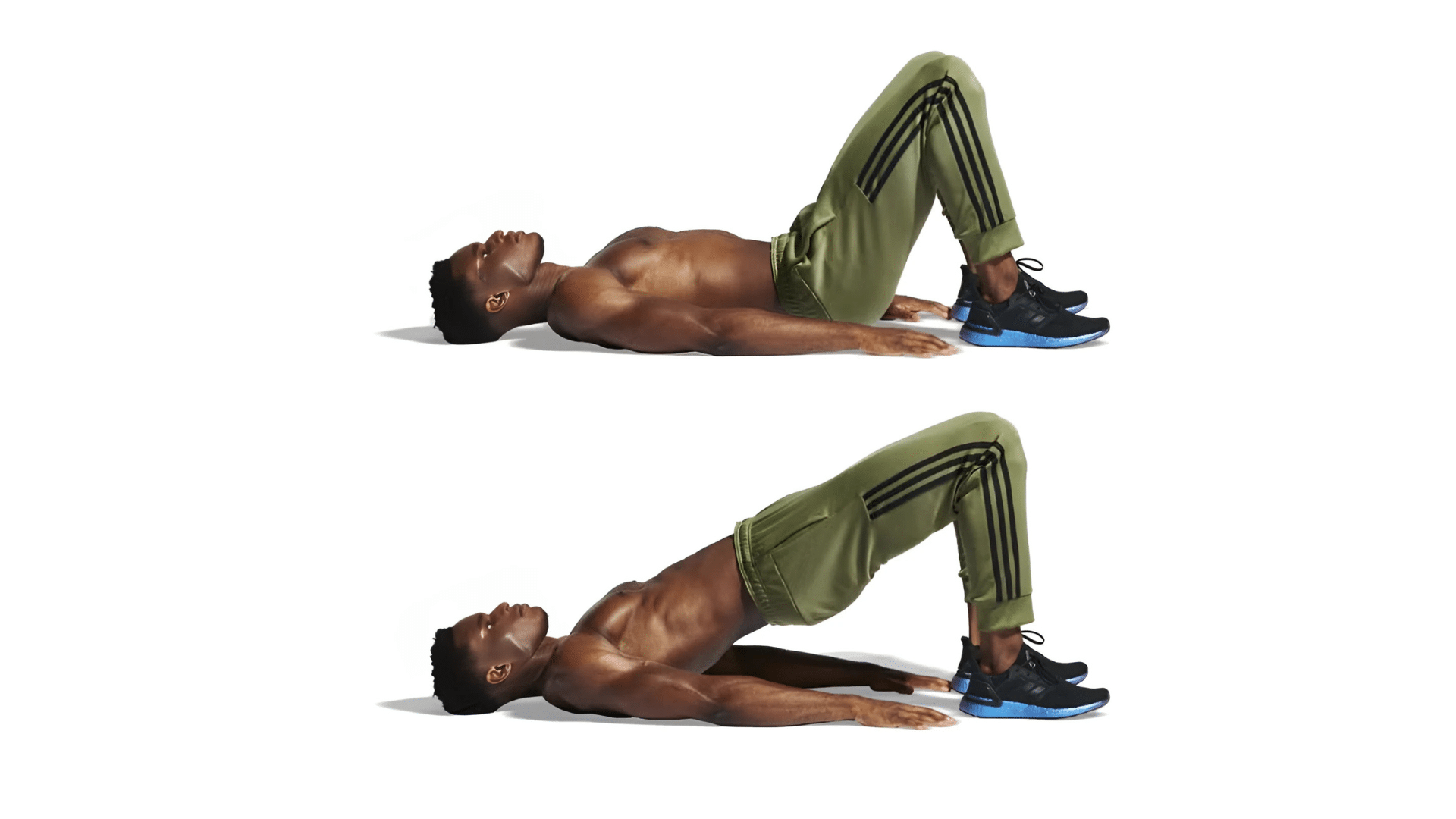
Risk Tags: lower back, neck
Screen (Readiness Test): Lie on your back, knees bent. Squeeze glutes and lift hips one inch. Hold 10 seconds without back pain. If you feel it in your lower back, shorten the lift and focus on the glute squeeze.
Step-by-Step Instructions
- Lie on your back, feet hip-width, close to glutes.
- Arms by sides, palms down.
- Brace core. Squeeze glutes.
- Press through heels and lift hips.
- Form a line from shoulders to knees.
- Pause one to two seconds.
- Lower slowly with control.
Common Mistakes
- Overarching the lower back instead of bracing the core.
- Knees drifting wide or knocking inward.
- Pushing through toes instead of heels.
- Letting ribs flare upward and losing control.
- Neck tensing or chin jutting up.
- Dropping hips quickly without control.
- Skipping the pause at the top of the lift.
5. Planks
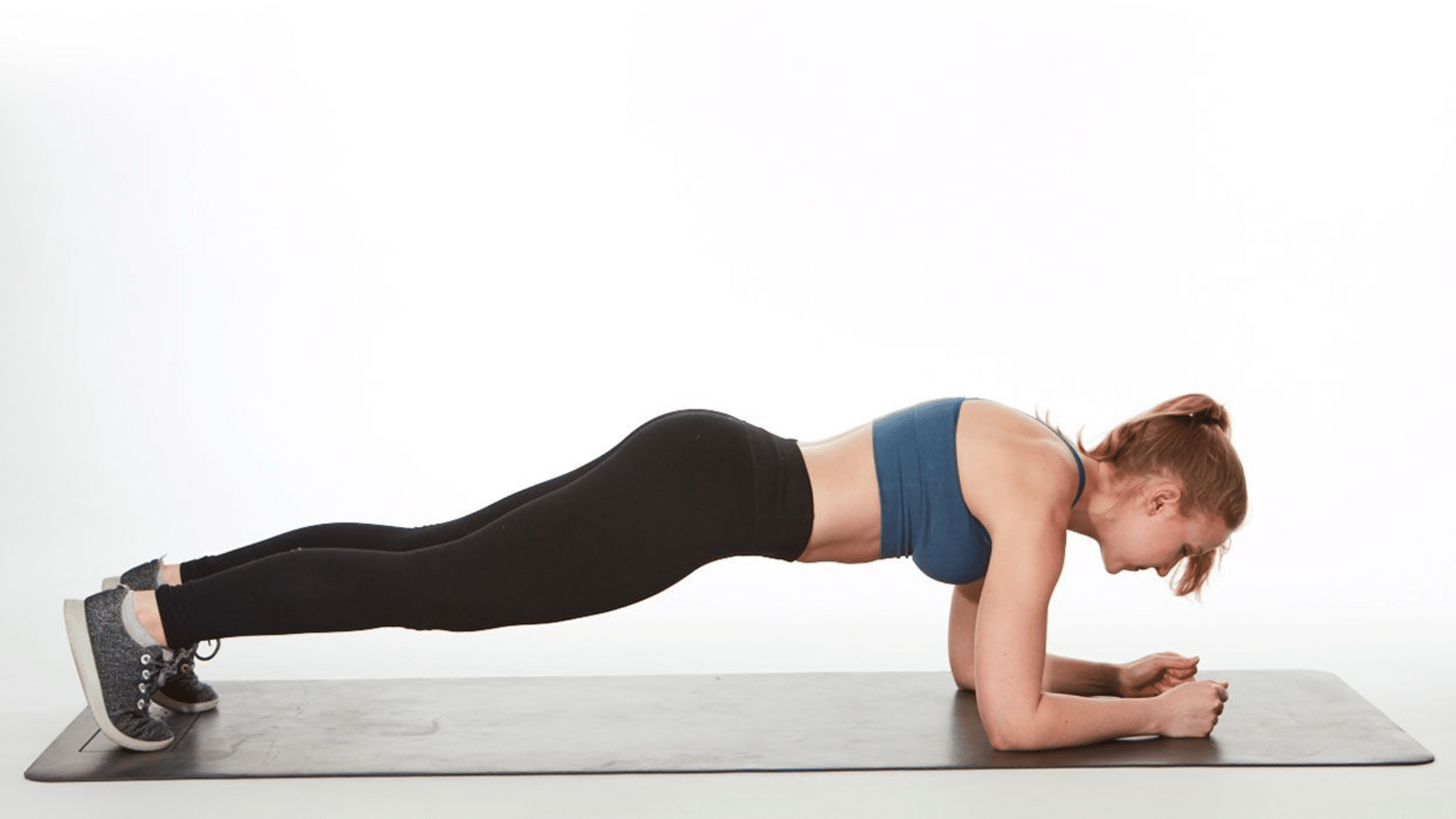
Risk Tags: wrists, shoulders, lower back
Screen (Readiness Test): From knees, set a forearm plank. Keep ribs down and glutes lightly squeezed for 15–20 seconds. If hips sag or low back aches, shorten the hold or use an incline.
Step-by-Step Instructions
- Set forearms under shoulders (or hands for high plank).
- Step feet back to a straight line.
- Squeeze glutes and brace core.
- Pull ribs down; keep neck neutral.
- Hold 10–30 seconds with steady breaths.
- Rest. Repeat for 2–3 sets.
- Stop if the form slips.
Common Mistakes
- Overarching the lower back instead of bracing the core.
- Knees drifting wide or knocking inward.
- Pushing through toes instead of heels.
- Letting ribs flare upward and losing control.
- Neck tensing or chin jutting up.
- Dropping hips quickly without control.
- Skipping the pause at the top of the lift.
6. Bird Dog
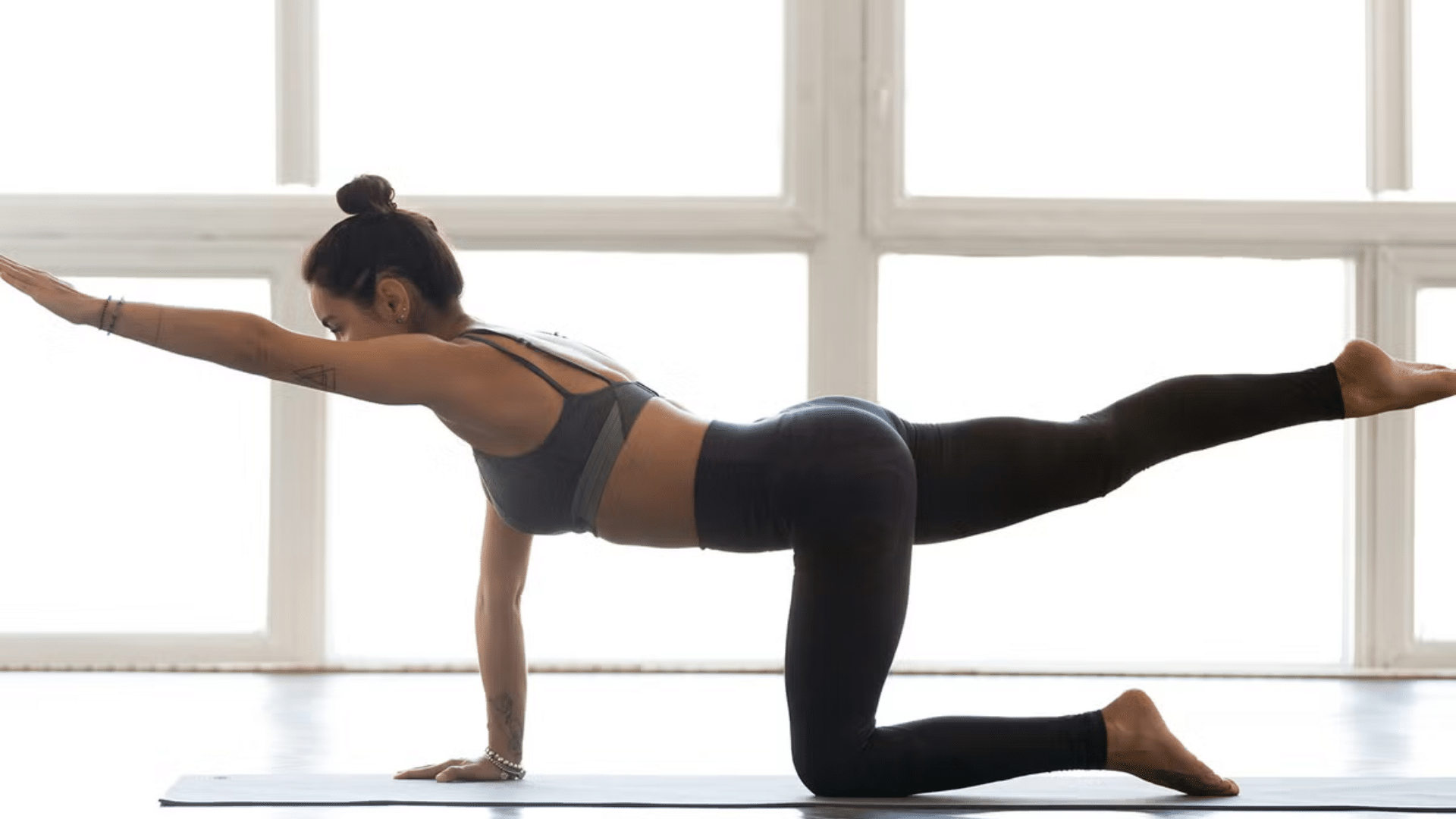
Risk Tags: lower back, balance, shoulders
Screen (Readiness Test): From the tabletop, lift one hand one inch and hold for five seconds without twisting. Then lift the opposite knee one inch. If hips shift, practice smaller lifts first.
Step-by-Step Instructions
- Start on all fours: wrists under shoulders, knees under hips.
- Brace core; keep spine long.
- Reach right arm forward, left leg back.
- Hips stay level. Gaze down.
- Hold two to three seconds.
- Return with control.
- Switch sides for 6–10 reps each.
Common Mistakes
- Hips rotating or tilting during the lift.
- Back arching or rounding instead of staying neutral.
- Arm or leg lifted too high.
- Speed over control between sides.
- Locked elbows are placing stress on joints.
- Neck craned up or tucked hard.
- Holding breath during the hold.
7. Step-Ups
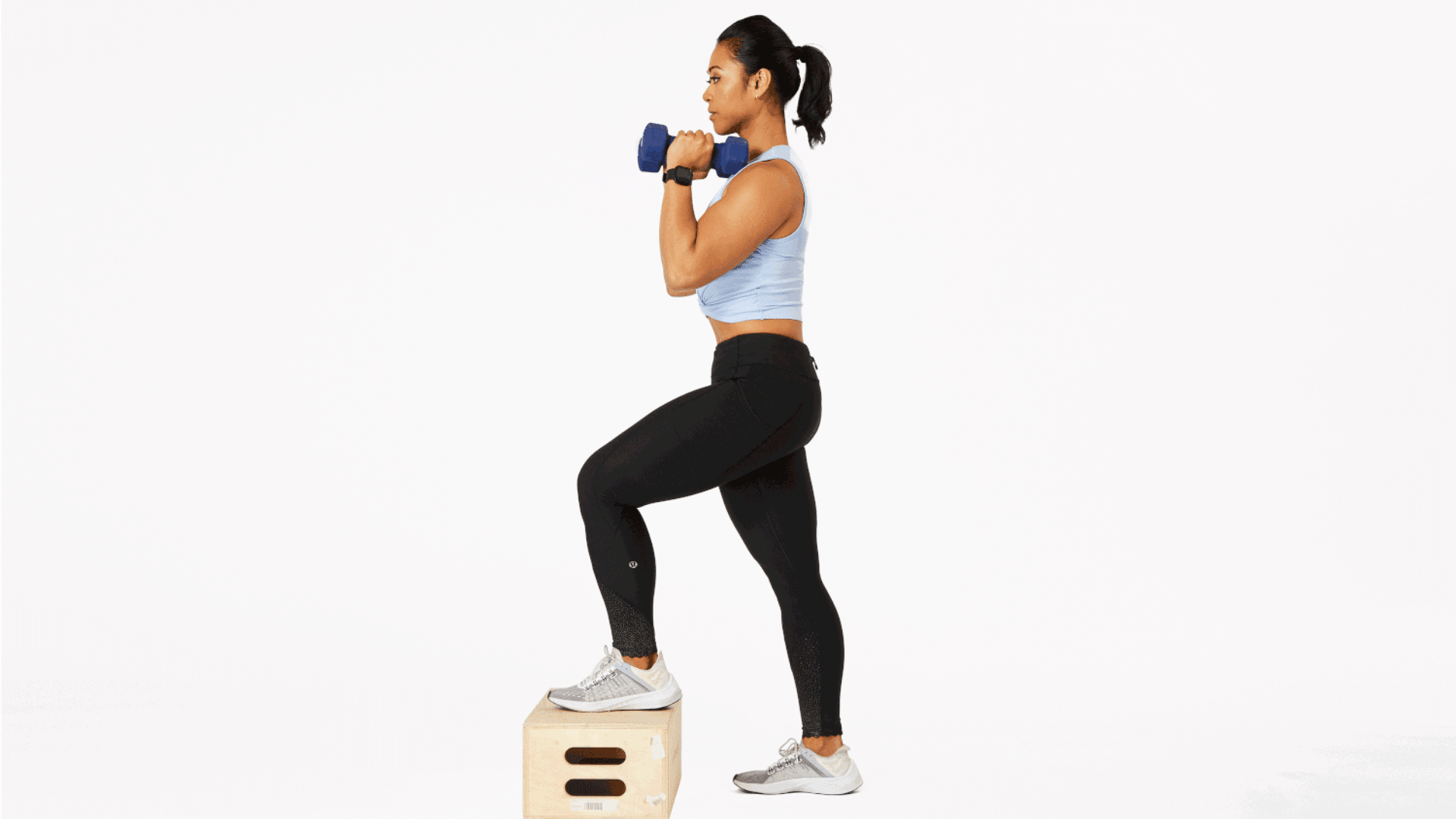
Risk Tags: knees, ankles, balance
Screen (Readiness Test): Place your whole foot on a low step. Step up and down five times per leg, quiet landings, no wobble. If the knee caves in or you push off the back leg, lower the height.
Step-by-Step Instructions
- Face a sturdy step or bench.
- Place the full foot of your lead leg on top.
- Brace core. Lean slightly forward.
- Press through the heel to rise.
- Bring the other foot up lightly (or tap).
- Step down with control.
- Switch legs each rep.
Common Mistakes
- Only part of the foot is on the step, leading to instability.
- Pushing off the trailing leg instead of using the lead leg.
- Knee collapsing inward on the way up or down.
- Standing too close or too far from the step.
- Fast, loud landings instead of controlled steps.
- Not engaging the core while stepping.
- Using an unstable or slippery surface.
Making Them Part of Your Routine
You don’t always need a set workout block; daily life provides opportunities to move. Here are some easy ways to make these exercises part of your routine:
- Do squats while waiting for your coffee to brew in the morning.
- Hold a plank during TV commercials or while streaming pauses.
- Try step-ups using your stairs or a sturdy step at home.
- Stretch before bed to loosen muscles and sleep more comfortably.
Small movements add up when repeated daily.
Quick Daily Routines to Incorporate in Your Daily Life
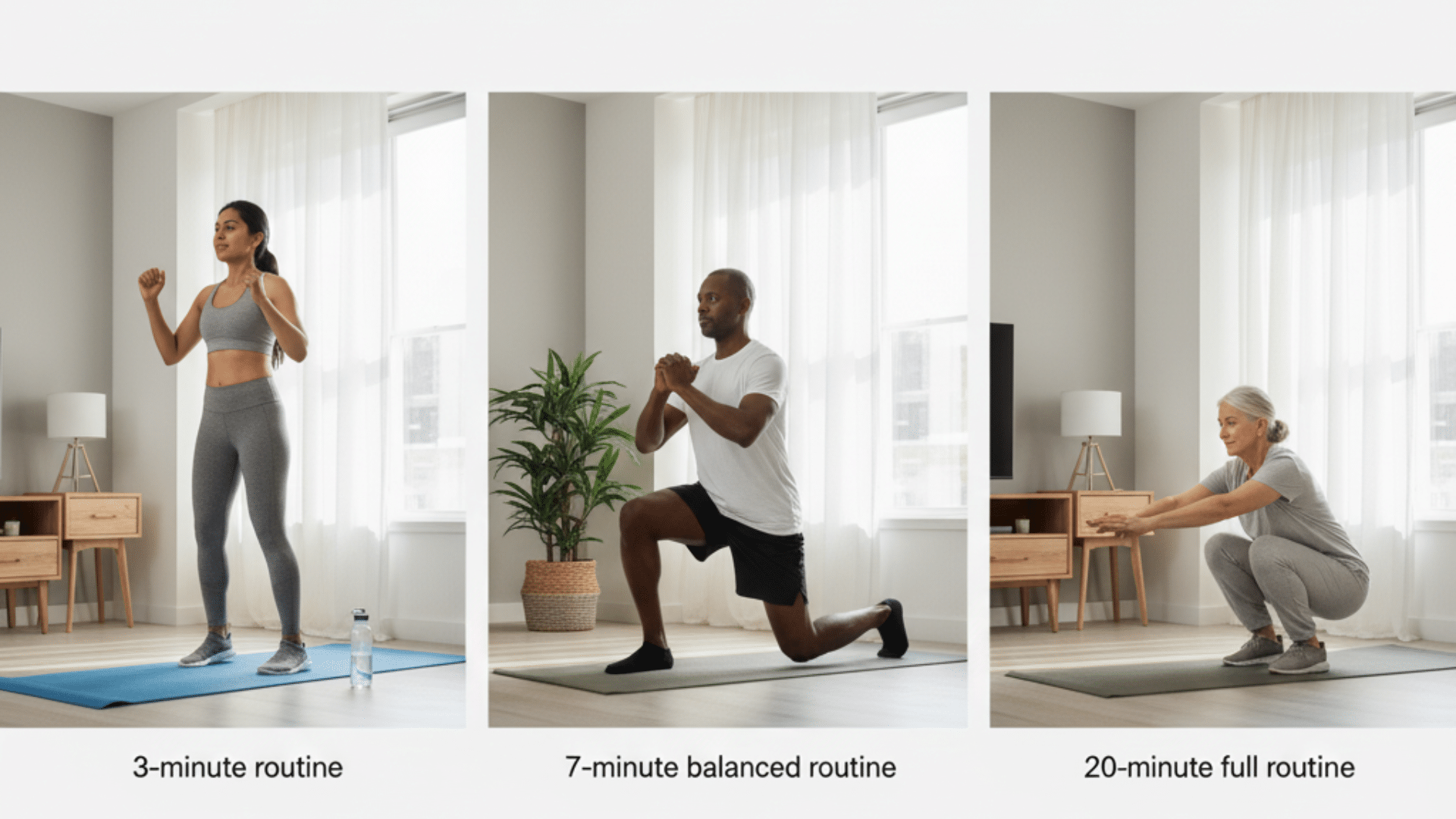
No matter how much time you have, you can fit in movement. Choose from 3-minute, 7-minute, or full 20-minute options.
3-Minute Micro Routine (For Busy Days)
Use this quick, full-body routine when your schedule’s tight. It gets your heart pumping and muscles working in just three minutes:
| Exercise | Time |
|---|---|
| Jumping Jacks | 30 seconds |
| Squats | 30 seconds |
| Push-Ups | 30 seconds |
| Plank | 30 seconds |
| Glute Bridges | 30 seconds |
| Stretch/Deep Breathing | 30 seconds |
7-Minute Balanced Routine (No Equipment)
This short workout balances strength, cardio, and core moves. It’s great if you want more variety without a long-term commitment:
| Exercise | Time |
|---|---|
| Warm-Up: March in Place | 1 minute |
| Squats, Lunges, Glute Bridges, Knee Push-Ups | 4 minutes |
| Plank or Bird Dog | 1 minute |
| Stretch or Yoga Flow | 1 minute |
Full 20-Minute Home Workout (Beginner-Friendly)
This full routine covers everything: warm-up, strength, cardio, and cool-down. It’s a great way to build consistency and total-body strength:
| Exercise Type | Details | Time |
|---|---|---|
| Warm-Up | Arm Circles, Leg Swings | 3 minutes |
| Strength | Squats, Push-Ups, Bridges, Lunges | 10 minutes |
| Cardio | Dance, Walk in Place, High Knees | 5 minutes |
| Cool-Down | Stretch + Breathwork | 2 minutes |
Training by Body Area (Target What You Need)
Not every workout needs to train everything at once. Sometimes it helps to focus on a specific area. Here are simple ways to target different body parts effectively:
1. Full-Body Combos
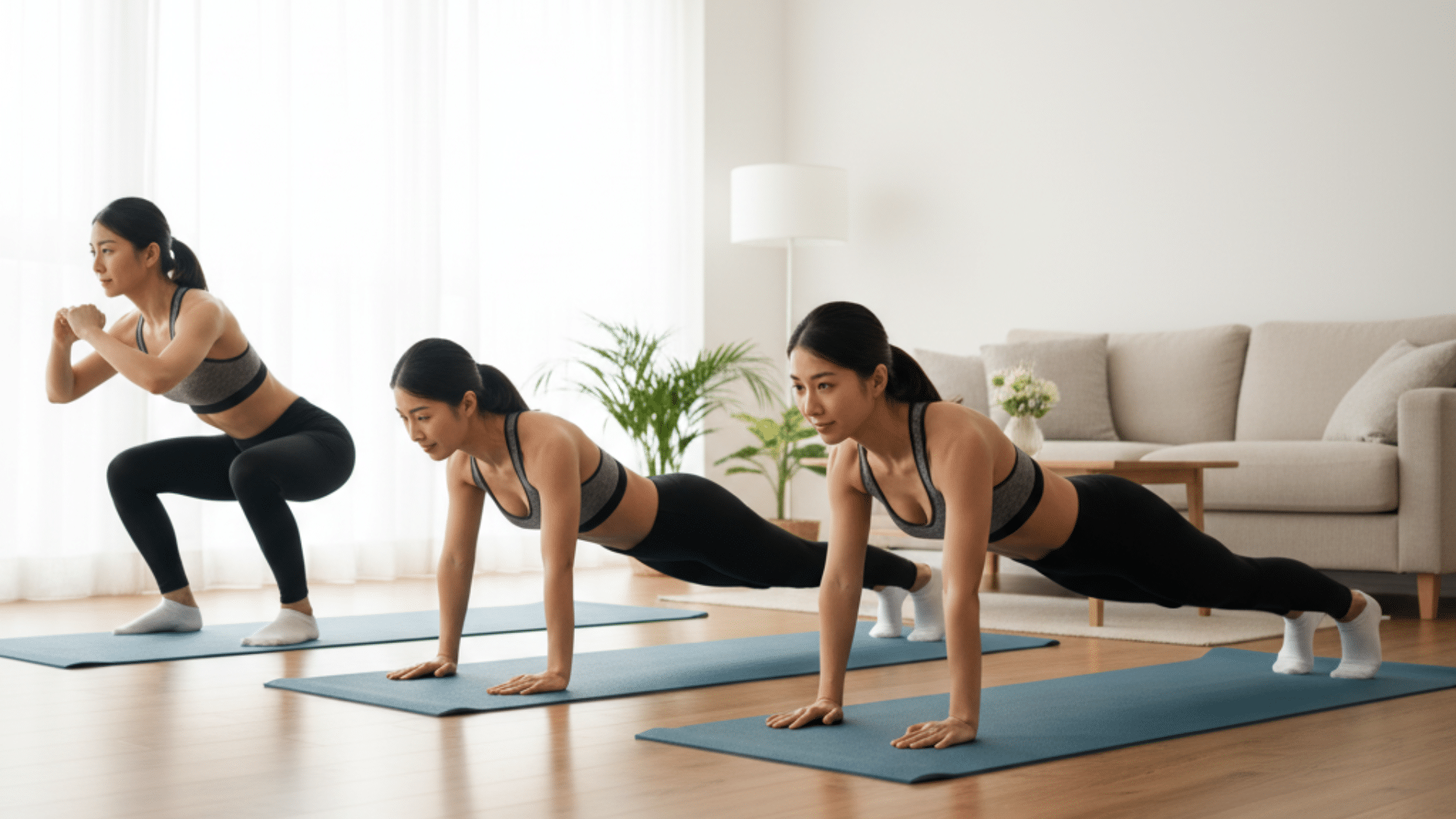
Risk Tags: knees, wrists, shoulders, lower back
Screen (Readiness Test): Perform 5 bodyweight squats, 5 wall push-ups, and hold a plank for 15 seconds without pain. If any movement causes discomfort, start with modified versions (chair squats, wall push-ups, knee plank).
Step-by-Step Instructions
- Warm up for 2–3 minutes with light marching or arm circles.
- Do 10–12 squats with heels down and chest lifted.
- Immediately perform 8–10 push-ups (wall, knee, or full).
- Hold a plank for 15–30 seconds with hips level.
- Rest 30–60 seconds and repeat the circuit 2–3 times.
- Focus on smooth breathing and steady tempo.
- Track form over speed.
Common Mistakes
- Knees are collapsing inward during squats.
- Hips sagging or hiking in push-ups and planks.
- Holding your breath instead of breathing steadily.
- Rushing between moves without regaining form.
- Skipping warm-up or cool-down stretches.
- Ignoring pain signals and pushing through discomfort.
- Not adjusting reps or holds to your fitness level.
2. Core Strength
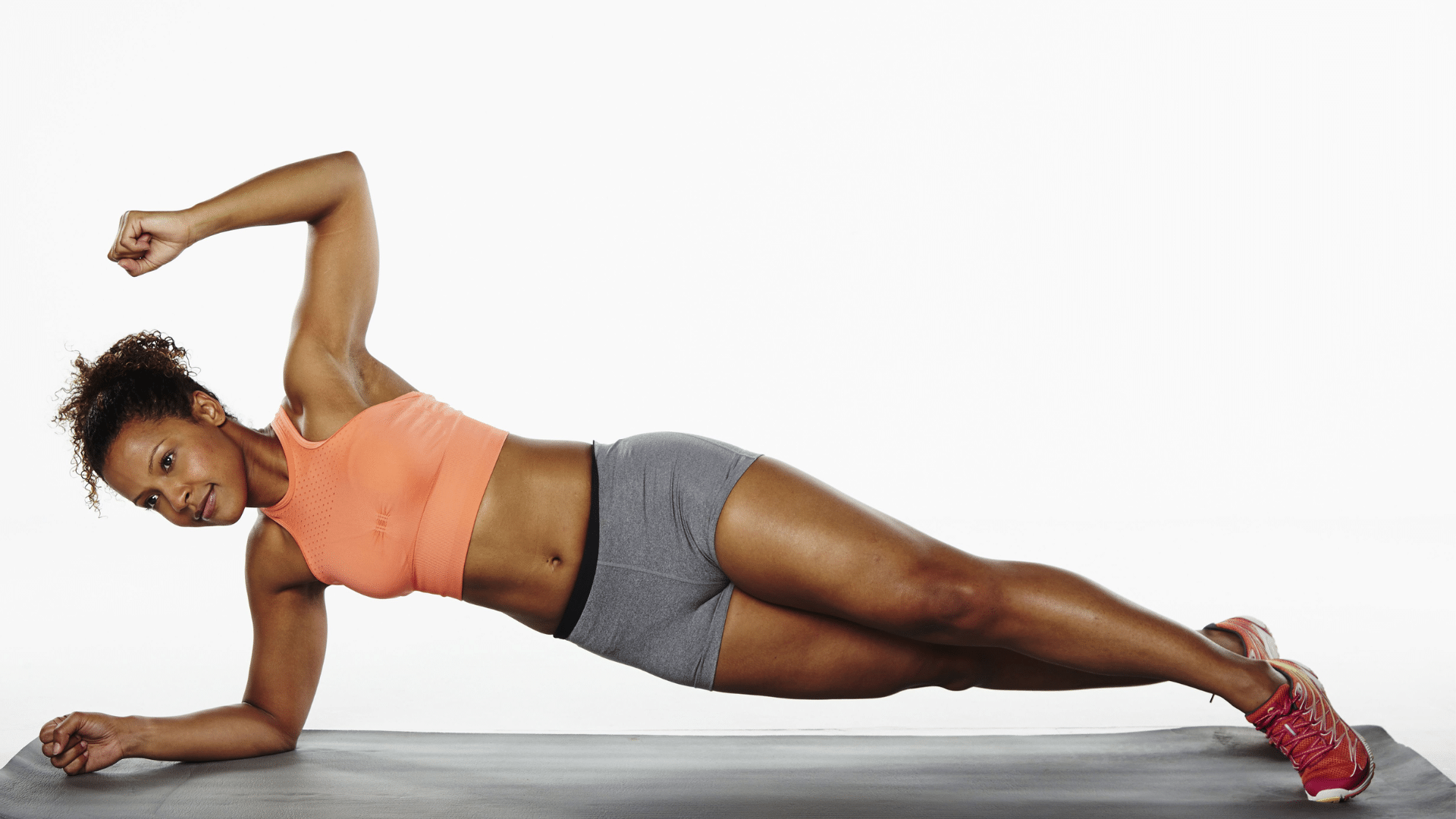
Risk Tags: lower back, neck, balance
Screen (Readiness Test): Lie on your side and hold a bent-knee side plank for 10 seconds. From all fours, lift one arm and opposite leg for 3 seconds. Perform 5 crunches without neck strain. If any of these cause discomfort, shorten holds or reps.
Step-by-Step Instructions
- Start with a 30-second bent-knee side plank on each side.
- Move to 6–8 bird dogs per side, holding each for 2–3 seconds.
- Finish with 10–12 slow crunches, lifting shoulder blades off the mat.
- Keep core braced and neck neutral throughout.
- Rest 30 seconds between moves.
- Repeat for 2–3 rounds.
- Progress time or reps gradually.
Common Mistakes
- Hips dropping or rotating in side planks.
- Arching the lower back in bird dog.
- Pulling on the neck during crunches.
- Moving quickly without control.
- Holding your breath under tension.
- Forgetting to engage core before each rep.
- Skipping rest and losing form in later rounds.
3. Leg & Glute Focus
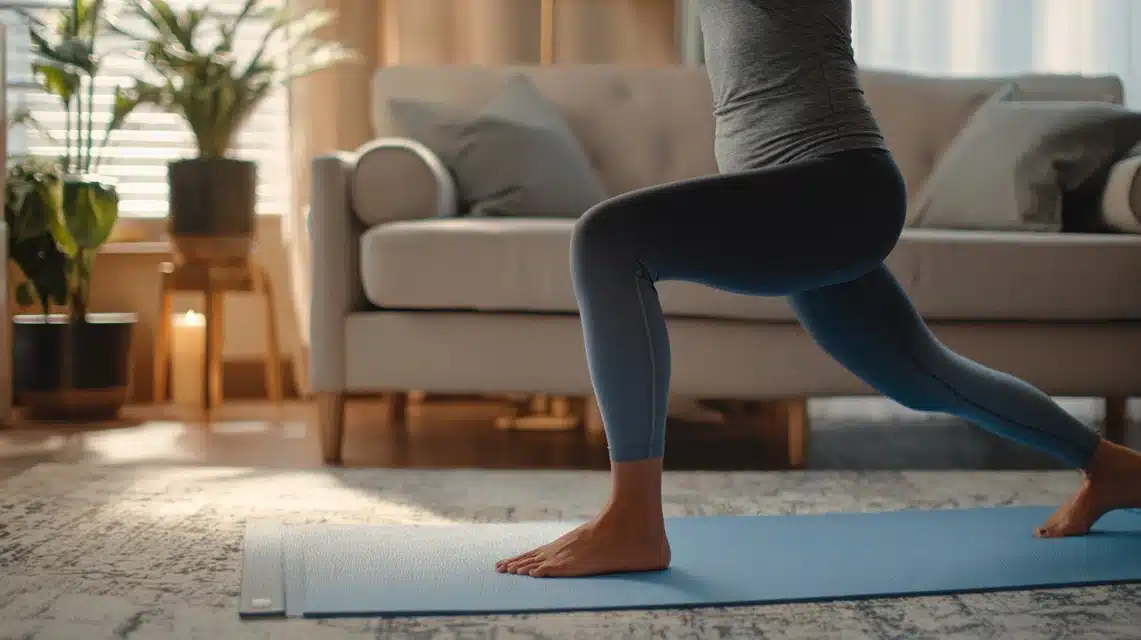
Risk Tags: knees, hips, ankles, lower back
Screen (Readiness Test): Perform 5 bodyweight squats, step into a small lunge without wobble, hold a bridge for 10 seconds, and step onto a low step without knee cave-in. If any cause discomfort, start with a smaller range of motion.
Step-by-Step Instructions
- Warm up hips and legs with light marching or hip circles.
- Do 10–12 squats with heels down.
- Perform 8 lunges per leg, keeping the front knee behind the toes.
- Lie down for 10–12 glute bridges, squeezing at the top.
- Finish with 8–10 step-ups per leg on a stable surface.
- Rest 30–60 seconds between moves.
- Repeat 2–3 rounds, focusing on smooth form.
Common Mistakes
- Knees collapsing inward on squats and lunges.
- Short or uneven strides cause unstable lunges.
- Arching the back in glute bridges.
- Only half the foot is on the step during step-ups.
- Rushing transitions between moves.
- Not bracing the core for balance.
- Ignoring pain and forcing the range of motion.
4. Upper Body
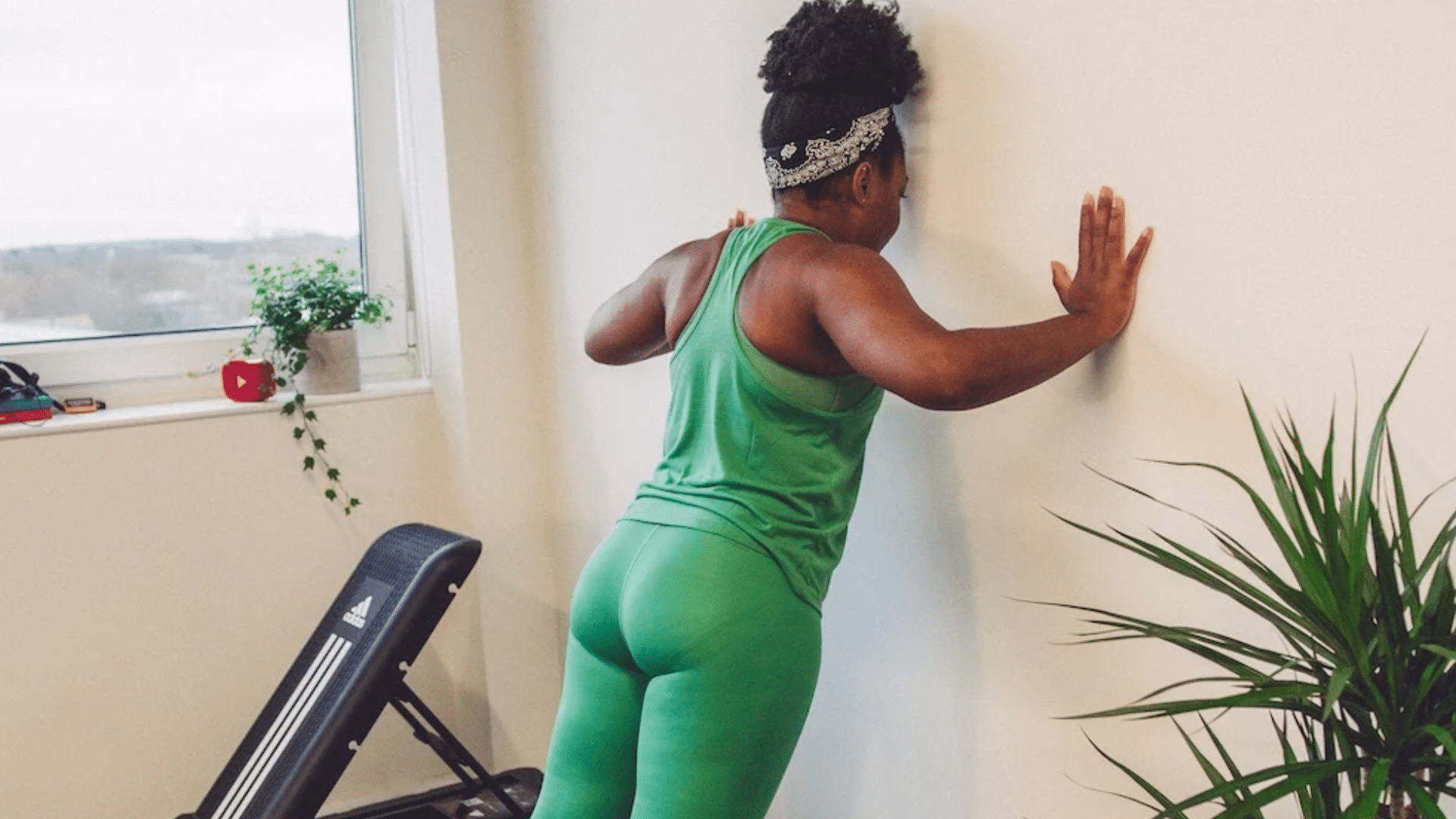
Risk Tags: wrists, shoulders, lower back
Screen (Readiness Test): Perform 5 wall push-ups without sagging hips, press light resistance overhead while keeping ribs pulled in, and lie face down lifting arms and legs a few inches without back pain.
Step-by-Step Instructions
- Do 10–12 wall push-ups with the body in a straight line.
- Grab light bands or water bottles and press overhead for 10 reps, ribs down.
- Lie face down and hold a superman lift for 5 seconds, repeat 6–8 times.
- Rest 30–45 seconds between moves.
- Complete 2–3 rounds.
- Focus on slow, steady reps.
- Breathe out during the effort phase.
Common Mistakes
- Hips sagging or back arching in wall push-ups.
- Letting ribs flare during overhead presses.
- Lifting weights too heavy and losing form.
- Neck strained upward in superman hold.
- Moving too fast without muscle control.
- Skipping warm-up for shoulders.
- Holding your breath during lifts.
5. Mobility & Flexibility

Risk Tags: hamstrings, spine, shoulders
Screen (Readiness Test): Stand tall and hinge forward to touch your shins without rounding the back. From all fours, arch and round your spine gently. Sit cross-legged and rotate your torso without discomfort.
Step-by-Step Instructions
- Stand and perform 8–10 slow toe touches or hamstring stretches.
- Drop to all fours for 6–8 cat-cow cycles, moving with breath.
- Sit cross-legged and do 6–8 seated twists on each side, breathing out on the twist.
- Hold each stretch 10–20 seconds without pain.
- Move gently and steadily.
- Finish with deep breathing to relax muscles.
- Repeat daily or after workouts.
Common Mistakes
- Forcing the stretch and bouncing at the end range.
- Rounding the lower back aggressively in toe touches.
- Dropping the head or overextending the neck in cat-cow.
- Twisting from the shoulders only instead of the torso.
- Holding breath during stretches.
- Moving too quickly instead of easing in.
- Skipping cool-down after intense exercise.
Daily Exercises by Age Group
Your body changes with age, so your routine should too. The best exercises can look different depending on your stage of life. Here’s a breakdown of daily movements suited for each age group to keep you active and healthy:
In Your 30s–40s
This is an ideal time to establish consistency with balanced routines that incorporate strength, cardio, and flexibility. Add bodyweight strength moves like squats and push-ups, then finish with light stretching.
Yoga can also help manage stress and improve recovery. Stay active most days of the week to maintain your energy levels, support your metabolism, and establish long-term exercise habits.
In Your 50s
Focus on exercises that protect joints, improve posture, and build strength without strain. Chair squats, wall push-ups, and resistance bands are helpful choices. These moves support daily function while reducing the risk of injury.
Prioritize balance and core stability, and don’t skip stretching. Staying consistent now helps reduce aches, protect bone density, and make it easier to stay active long term.
In Your 60s & Beyond
Stick to low-impact exercises that keep you moving safely. Walking, seated leg raises, and water aerobics are gentle on joints and still effective.
Add tai chi, simple stretching, or light resistance training to stay flexible and strong. Always go at your own pace. These daily movements support balance, reduce fall risk, and help you feel steadier and mobile.
Customizing Your Routine Based on Current Fitness Level
Start where you are. This table helps you adjust your daily routine based on your current fitness level and comfort:
| Level | What to Focus On |
|---|---|
| Beginner | Do 3–5 basic moves like squats, glute bridges, or wall push-ups. Start with one round at low reps. Focus on slow, steady form instead of speed or reps. Take breaks if needed. |
| Intermediate | Add a second round or extend your time. Mix in light cardio like marching or jumping jacks. Start combining strength and movement for better results. |
| Advanced | Use resistance bands or light weights. Include compound exercises like burpees or planks with rows. Challenge yourself with full circuits. |
Track Your Progress with Tools and Apps
Keeping track of your workouts helps you stay consistent and motivated. A simple checklist or chart lets you mark off completed exercises, note how you felt, and adjust based on energy.
Seeing progress build over time makes it easier to stay committed, even on slower days. If you prefer digital tools, try apps that simplify the process.
Google Fit makes daily tracking easy, MyFitnessPal combines workouts and nutrition, and Habitica gamifies habits with rewards. Choose the method that feels natural, and focus on steady progress, not perfection.
Tips to Stay Consistent In Physical Exercise at Home
Daily movement is easier when it feels manageable. Building a routine is one thing, but sticking with it is what really makes the difference. Here are some simple tips to help you stay on track:
- Set a reminder or alarm so you don’t forget
- Keep workouts short and realistic to avoid burnout
- Play music or a podcast to make it more enjoyable
- Use a tracker and celebrate small wins with a checkmark
- Don’t aim for perfect, just aim to show up
- Stack it with another habit (like after brushing teeth or morning coffee)
- Try different times to see what works best
Staying consistent doesn’t mean being perfect. Focus on showing up regularly, and over time, those small efforts will lead to big results.
Conclusion
I used to think moving every day had to be hard. But now, I just keep it simple and do the same small moves each day. I follow 7 easy exercises that help me stay strong, steady, and flexible. I don’t need a gym or fancy gear, just a few minutes and a bit of space.
You can do the same. Start with what feels right for your body. Try things like squats, push-ups, planks, and step-ups. You don’t have to do them all at once. Use timers or apps if that helps you stay on track.
The trick is to keep going, even on slow days. Want more simple ideas? Go check out the fitness posts on the site!

